 David Cote
David Cote
Realism, minimalism, racism, intellectualism, anti-Semitism: potent performances and too-much theatrics in a revival of Lorraine Hansberry’s 1964 play.
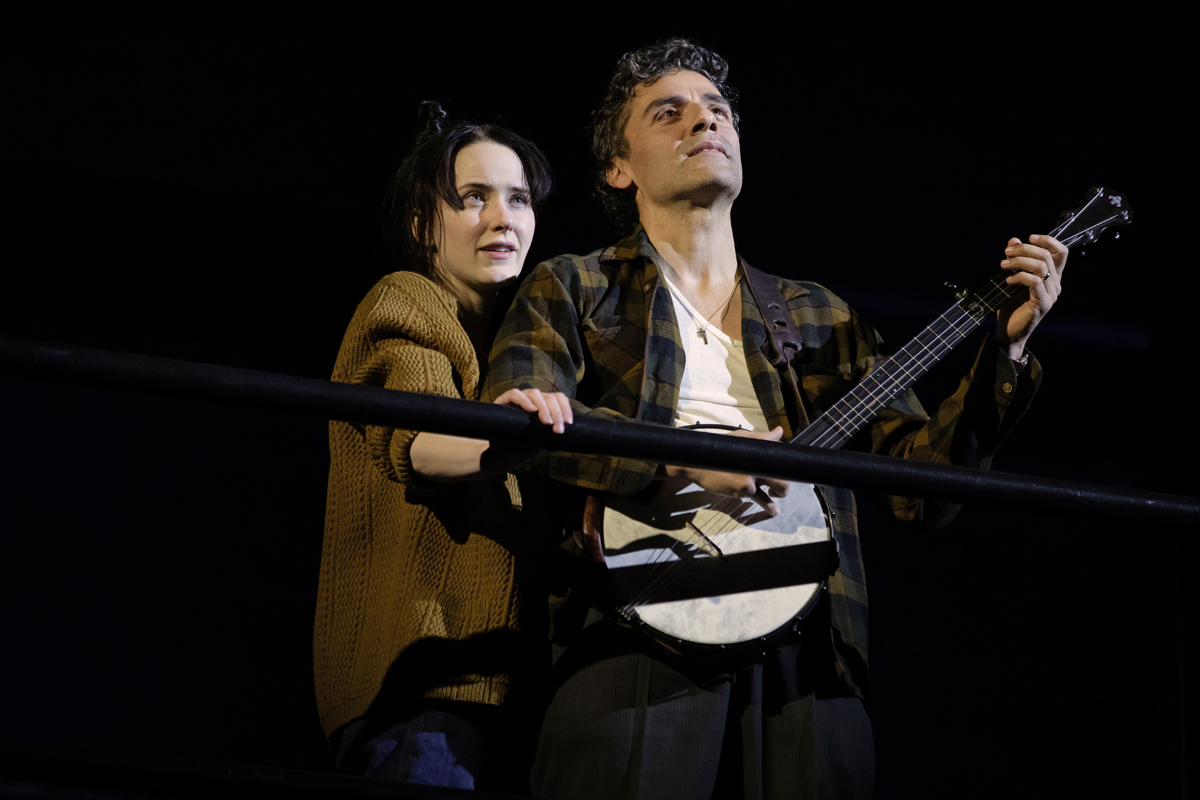
Rachel Brosnahan as Iris Parodus Brustein and Oscar Isaac as Sidney Brustein in The Sign in Sidney Brustein’s Window. Courtesy the Brooklyn Academy of Music. Photo: Julieta Cervantes.
The Sign in Sidney Brustein’s Window, written by Lorraine Hansberry, directed by Anne Kauffman, BAM Harvey Theater, 651 Fulton Street, Brooklyn, through March 24, 2023
• • •
No one told Lorraine Hansberry what was killing her. She knew she was seriously ill: the dramatist had been in and out of hospitals for two years. Before her second play began previews on Broadway at the Longacre on October 15, 1964, she moved into the Victoria Hotel on Seventh Avenue, with a day nurse, to be near the production. Despite excruciating shingles, numbness of limbs, and brain fog, Hansberry attended opening night. Still, no one explained that inoperable pancreatic cancer was destroying her organs. After ugly reviews and 101 performances, the play closed the night Hansberry died, age thirty-four.
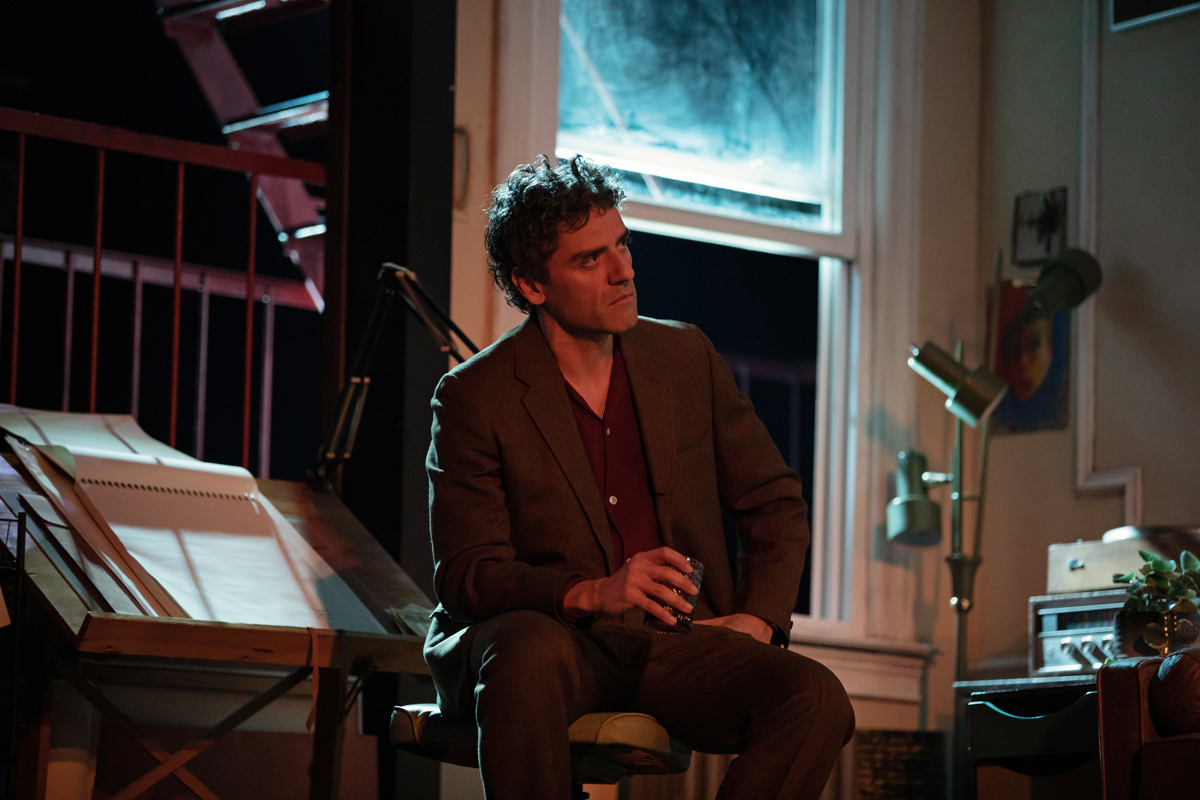
Oscar Isaac as Sidney Brustein in The Sign in Sidney Brustein’s Window. Courtesy the Brooklyn Academy of Music. Photo: Julieta Cervantes.
It’s hard to accept that a writer so intent on diagnosing social rot—just five years earlier, Hansberry had shown Broadway the curse of institutional racism on Black families with A Raisin in the Sun—should be shielded from the truth of her disease. Magical-thinking doctors deemed ignorance a kind of medicine. Her ex-husband Robert Nemiroff (who had divorced her at the height of her illness, just six months before her death, and would become her literary executor) said it was anemia and bleeding ulcers. Whether or not Hansberry actually believed him, she did bequeath the so-called ulcer to Sidney Brustein, the fractious and slippery cynosure of The Sign in Sidney Brustein’s Window, currently on view at BAM. In this near-optimal revival of an exasperating, overstuffed play, director Anne Kauffman reveals a work that is forward-leaning in its interpersonal politics even as it is weighed down by theatrical conventions.
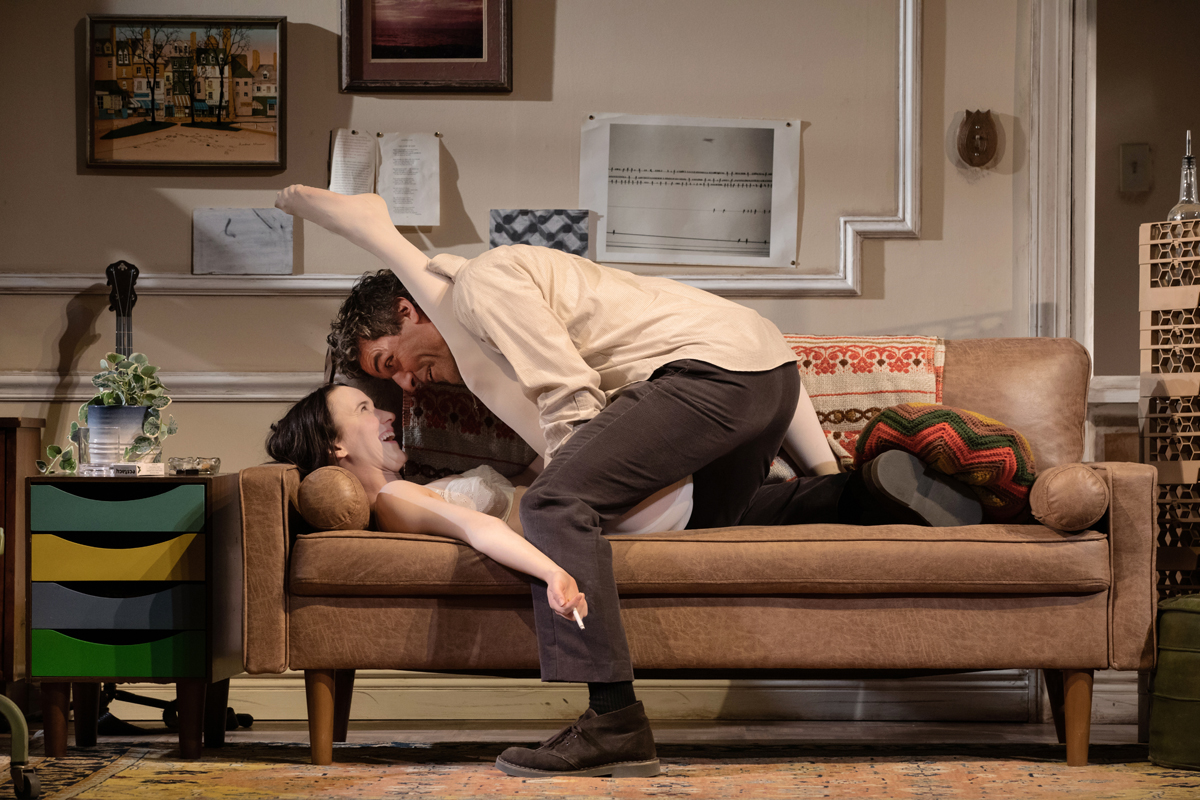
Rachel Brosnahan as Iris Parodus Brustein and Oscar Isaac as Sidney Brustein in The Sign in Sidney Brustein’s Window. Courtesy the Brooklyn Academy of Music. Photo: Julieta Cervantes.
A rhetorically lavish but intimate tale of hypocrisy among Greenwich Village bohemians, the action is grounded in the scruffy one-bedroom apartment of Sidney and Iris Brustein (Oscar Isaac, Rachel Brosnahan). Self-consciously performative and wryly hip, the often-bickering but tightly entwined couple lash into each other’s illusions, only to make up later. She—a “Greco-Gaelic-Indian hillbilly” from rural Oklahoma—waits tables between auditions, batting down the fear she lacks talent. Sidney—a Jewish, proudly ex-radical intellectual—wanders from one dud enterprise to the next. At the top of the play he lugs home racks of drinking glasses and booze from a failed folk-music nightclub. Undaunted, Sidney has his next venture lined up: editor of the Village Crier, a floundering local newspaper.

Julian De Niro as Alton Scales and Andy Grotelueschen as Wally O’Hara in The Sign in Sidney Brustein’s Window. Courtesy the Brooklyn Academy of Music. Photo: Julieta Cervantes.
When Wally O’Hara (Andy Grotelueschen), a self-styled reform candidate opposing “bossism,” asks Sidney’s paper to back him, he refuses. “I have lost the pretensions of the campus revolutionary,” Sidney declares. “I no longer have the energy, the purity or the comprehension to—‘save the world.’ ” Still, O’Hara promises to combat drug traffic in the neighborhood, and his zeal, stoked by Sidney’s friend, Alton (Julian De Niro), inspires Sidney to hang a campaign sign in his window and join the cause. As Sidney increasingly commits to O’Hara’s movement, Iris drifts into sleazy showbiz liaisons that dangle commercial gigs. She learns, and eventually tells Sidney, that O’Hara is not the progressive saint he seems. Both spouses, wittingly or not, are on the road to selling out.
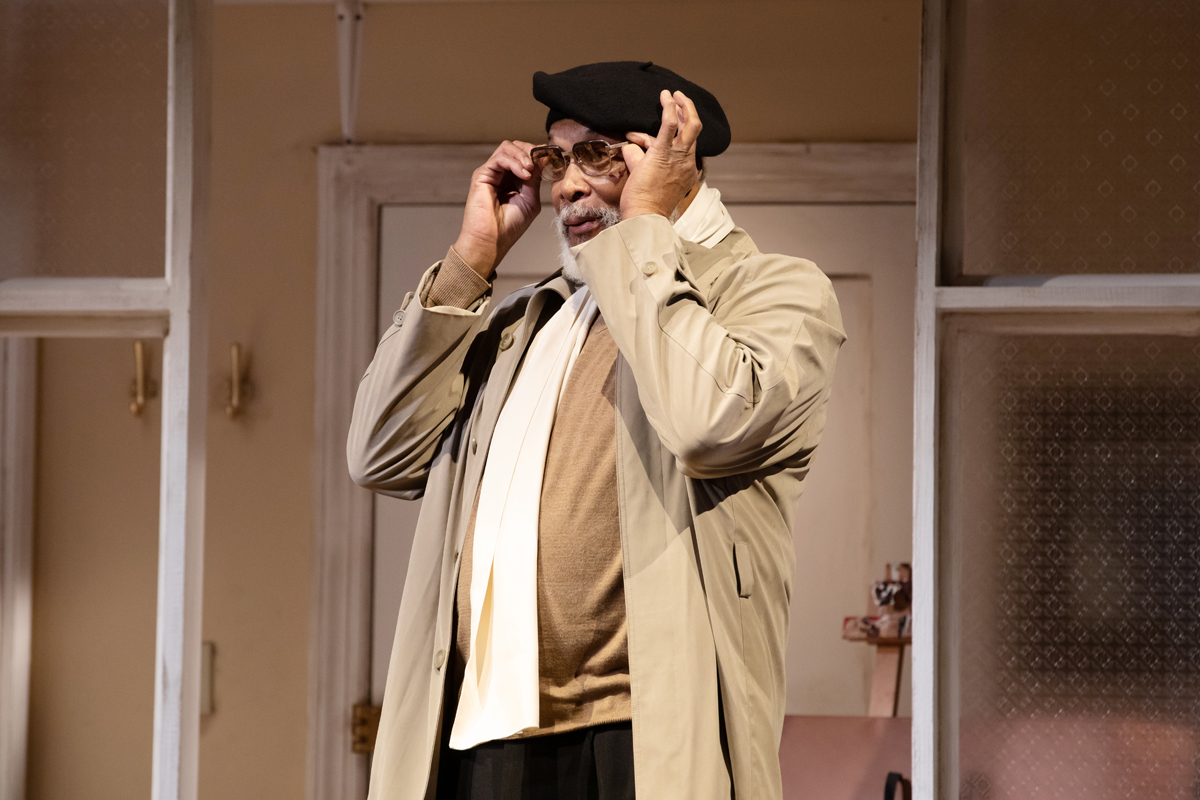
Raphael Nash Thompson as Max in The Sign in Sidney Brustein’s Window. Courtesy the Brooklyn Academy of Music. Photo: Julieta Cervantes.
Not content with the marriage play as morality tale, Hansberry rolls out secondary characters to thicken the ethical brambles: Alton is a light-skinned Black man nursing a lifetime of resentment about how his family accepted “the white man’s leavings.” He has fallen in love with Iris’s younger sister, Gloria (Gus Birney), unaware that she’s a call girl (and thus, to him, trash). Iris has another sister, the married Mavis (Miriam Silverman), who represents white, middle-class complacency with its own secrets. Abstract expressionist painter-fop Max (Raphael Nash Thompson) breezes in and out for comic relief as an avant-garde punching bag for Hansberry’s aesthetic conservativism. Finally, there’s an Edward Albee stand-in named David (Glenn Fitzgerald), the gay playwright from upstairs writing cryptic allegories about homosexuality and isolation. Another target of Hansberry’s disdain, David stands for aloofness, ambivalence—anything but Ibsen.

Oscar Isaac as Sidney Brustein and Glenn Fitzgerald as David Ragin in The Sign in Sidney Brustein’s Window. Courtesy the Brooklyn Academy of Music. Photo: Julieta Cervantes.
Sidney Brustein founders in a maximalism that could be described as everything plus Ibsen: a sludgy stew of Odets’s muscular cynicism and Chekhovian ennui with sexual psychodrama thrown in to furnish a sacrificial goat (Gloria) that justifies Sidney and Iris’s teary, last-minute redemption. Sidney, a prattling compound of Hamlettian melancholy and Alcestian crankiness, alludes to Thoreau, Shakespeare, Camus, Strindberg, Kurosawa’s Rashomon, and Jewish history. As in Raisin, toward the end a corrupt and corrupting white man is shown the door; but what was triumph in the earlier work is bathos here. Lurching from naturalism to satire and ultimately resolving in preachy melodrama, the three-hour affair is desperately in need of focus.
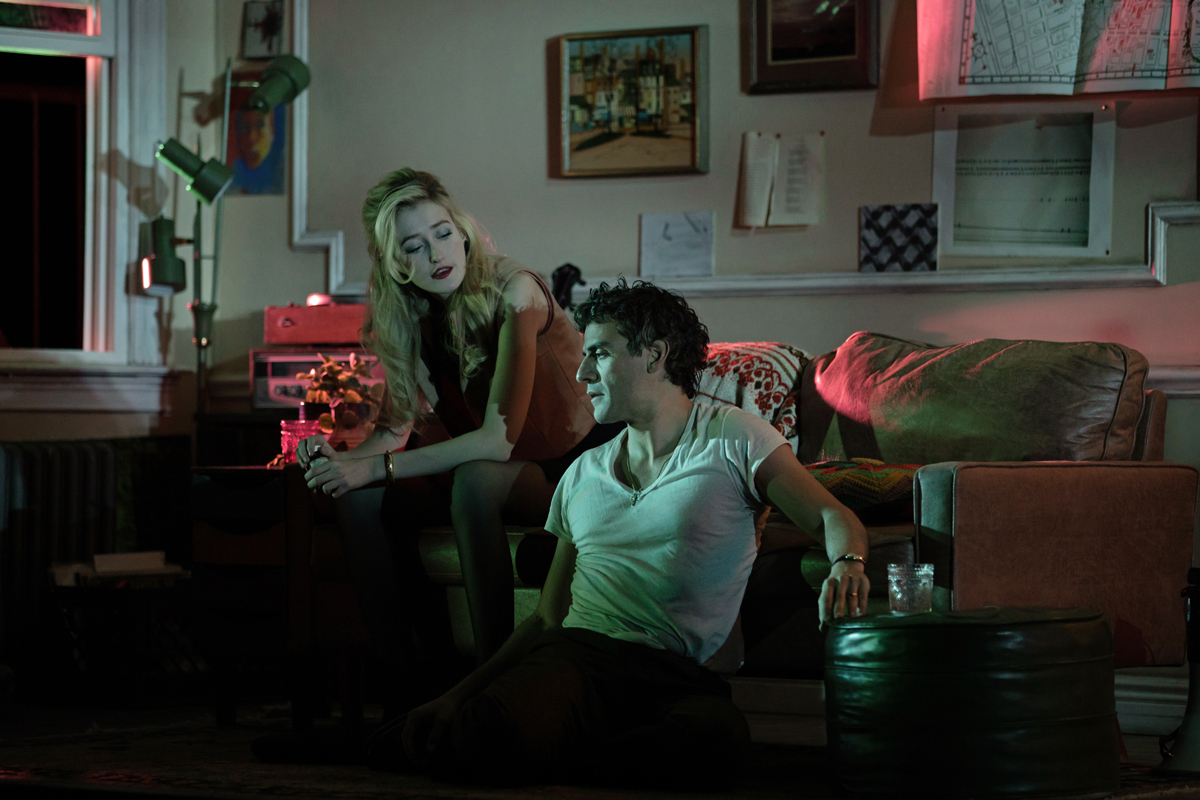
Gus Birney as Gloria Parodus and Oscar Isaac as Sidney Brustein in The Sign in Sidney Brustein’s Window. Courtesy the Brooklyn Academy of Music. Photo: Julieta Cervantes.
For at least the first half, this cluttered dramaturgy is mitigated by charming, sensitive performances. Isaac and Brosnahan not only make an attractive young couple, they handle the buffets of banter with verbal grace. Fitzgerald’s intriguing blend of diffidence and ire endows David with a dignity and decency that the script unfortunately undermines. Perversely, Hansberry gives uptown square Miriam some of the most cutting lines—“I am standing here and I am thinking: how smug it is in bohemia”—to which Silverman does justice. Only De Niro falters, with an Alton who’s far too bland and hesitant.
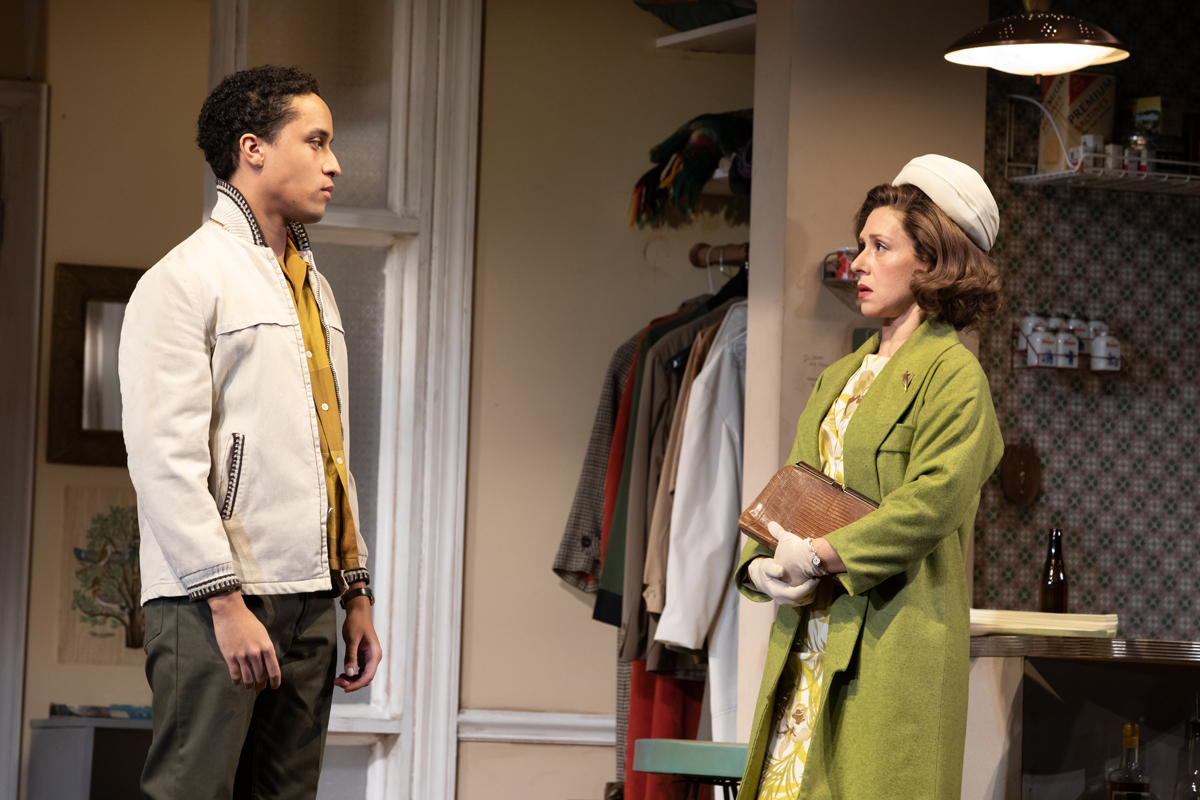
Julian De Niro as Alton Scales and Miriam Silverman as Mavis Parodus in The Sign in Sidney Brustein’s Window. Courtesy the Brooklyn Academy of Music. Photo: Julieta Cervantes.
Kauffman and her designers frequently unite the stylistic threads by alternating claustrophobic realism with sleek minimalism. The sets, by the collective known as dots, present the Brustein pad as a period interior elevated from the stage floor, floating in the chic, exposed dilapidation of the BAM Harvey like an island above ruins. While the apartment is minutely detailed, a fire escape stage right leads to a shadowy, bare upper zone, an abstract space where David taps at his typewriter and Sidney flees to pretend the skyline is a pastoral expanse. Kauffman employs the physical levels as pressure valves for the play’s narrative too-muchness, using them to impose a gulf between Sidney and Iris as they share their dreams, or to bring in offstage characters as fourth-wall-breaking witnesses to a boozy, druggy freak-out that occurs in the second act.
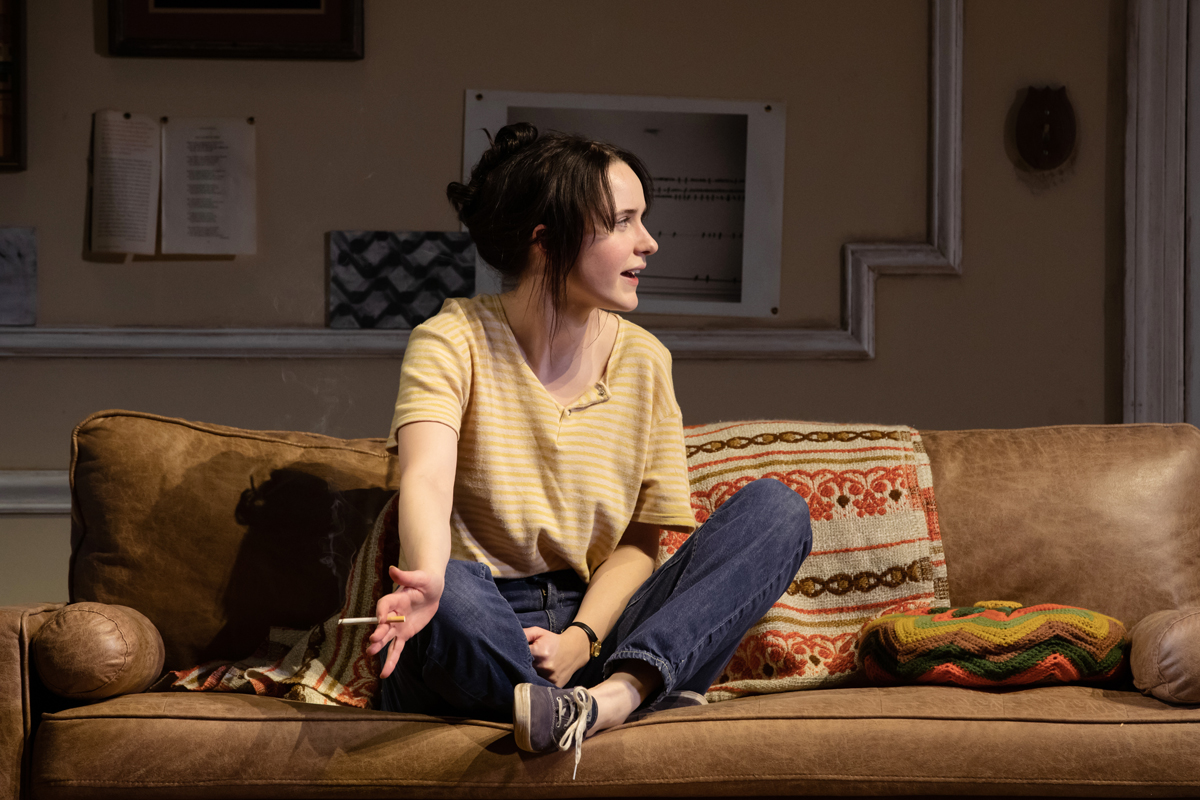
Rachel Brosnahan as Iris Parodus Brustein in The Sign in Sidney Brustein’s Window. Courtesy the Brooklyn Academy of Music. Photo: Julieta Cervantes.
What’s still powerful and resonant in Hansberry today is the necessity of radical empathy and a frank accounting of human weakness. We may feel there should be intersectional solidarity among her Black, queer, Jewish, and feminist avatars, but they turn on each other, projecting sexual fetishes or fears. Sidney patronizes and belittles Iris while cultivating a fantasy of her as his spritely “mountain girl.” Alton covets Gloria’s glamour; when he discovers that she’s a sex worker, his disappointment explodes as misogyny mixed with injured pride. “The white man done wrapped his trash in tinsel and give it to the n—— again, huh, Sidney?!” Alton rages. Referring to his enslaved ancestors, he adds, “I am spawned from commodities—and their purchasers!” Mavis toggles between casual racism and anti-Semitism, while freely admitting her husband keeps a mistress and illegitimate son.
For all its potent language and the refreshing spectacle of flawed idealists debating, without concern for online censure, how to be compassionate participants in a diverse society, Sidney Brustein remains a tough sit. It would take a far more drastic edit to reclaim this “lost classic.” (I’d nominate Lynn Nottage, Hansberry’s descendent in tough social realism, not blood.) Or we could respect her last pages and leave them be. Hansberry was beloved in her time and profoundly mourned when she left. A Raisin in the Sun is a legacy any playwright would envy. With Brustein, the sign still hangs, it tells us some truths, but the ink has faded.
David Cote is a theater critic, playwright, and librettist based in Manhattan. He reviews theater for Observer. His work has been produced in New York, Cincinnati, Chicago, and London.